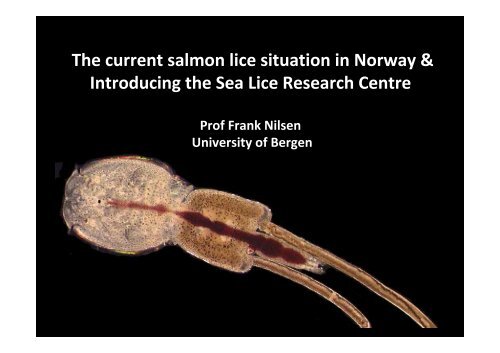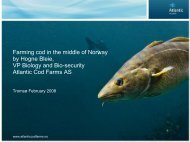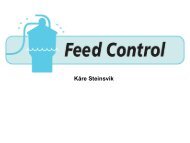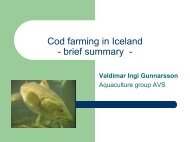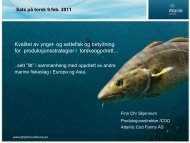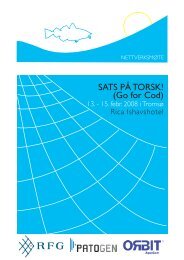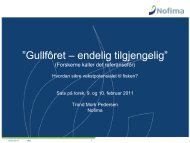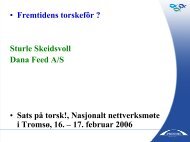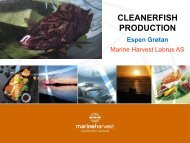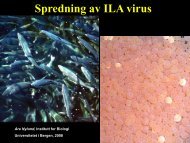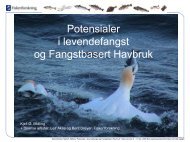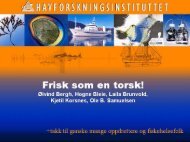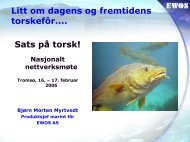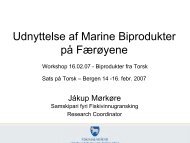Salmon Louse
Salmon Louse
Salmon Louse
You also want an ePaper? Increase the reach of your titles
YUMPU automatically turns print PDFs into web optimized ePapers that Google loves.
The current salmon lice situation in Norway &<br />
Introducing the Sea Lice Research Centre<br />
Prof Frank Nilsen<br />
University of Bergen
<strong>Salmon</strong> louse a major problem<br />
• Why is sea lice difficult to control?<br />
• Life cycle properties<br />
– Long lived, reproductive capacity, dispersal stages<br />
– Adapted to low and variable host density<br />
• Increased number of available hosts<br />
• Wild reservoir (i.e. wild salmonids)
But first<br />
a little taste of lice biology
Naupli I hatch from the egg-strings<br />
Naupli I<br />
Dark mature eggs<br />
1 egg = 0.7-0.8 copepodids<br />
Copepodid
Time (days)<br />
Temperature
Post settlement growth of copepodids
Copepodid – chalimus<br />
transition
Stressrelated responce<br />
Visible damage<br />
Secretion<br />
Immunomodulation<br />
Strong immune responce from lice<br />
BUT, does not remove the parasite
<strong>Salmon</strong> louse on farmed fish:<br />
• Coordinated treatment to obtain low lice levels in May/June<br />
• Based on medicine<br />
Goal: Low lice levels when wild Atlantic salmon smolt migrates<br />
• Infection pressure on wild stocks is monitored<br />
• Limit of lice larvae release not known
Treatment effort
Anti salmon louse drug consumption
Large increase in drug usage
Drug resistance - NORWAY<br />
Large problems related to organophosphates<br />
early/midd 1990<br />
New highly efficient drugs available from 1995<br />
2006/2007 cases with treatment failure<br />
Resistance identified in 2007 (Trøndelag)<br />
2010 resistance occurring from Rogaland to Lofoten,<br />
against 1, 2 or 3 drugs<br />
Limited cost seen in resistant lice strains
Increase in production
<strong>Salmon</strong> louse and the big numbers<br />
• 1.000.000 salmon in a farm, 0.1 female/fish<br />
• What does that mean?<br />
– 75 copepodids/lice/day<br />
– Produce 7.500.000 copepodids/day<br />
• What if these lice are resistant?<br />
• With few available medicines new tools need<br />
to be developed
Sea Lice Research Centre<br />
4 academic partners:<br />
•University of Bergen (host)<br />
•Norwegian School of Veterinary Sciences<br />
•Institute of Marine Research, Norway<br />
•UNI Research<br />
5 industrial partners:<br />
•Novartis AH<br />
•Ewos Innovation<br />
•Pathogen Analysis<br />
•Marine Harvest<br />
•Lerøy Seafood gr.
What is an SFI?<br />
SFI = Centre for Research based Innovation<br />
One of two “centre funding” from<br />
Norwegian Research Council (NRC)<br />
Selection based on “free competition” between<br />
diverse application<br />
NRC provides 5+3 years of funding<br />
(~10 mill NOKs/year), requires 50% own<br />
funding (> 25% industrial funding)
Sea Lice Research Centre<br />
Research to “develop” new control measures<br />
against sea lice<br />
Main goal:<br />
The <strong>Salmon</strong> <strong>Louse</strong> Research Centre aims at becoming world<br />
leading on research on salmon louse and similar parasites.<br />
The nature of the centre will facilitate development of new<br />
methods for lice control and shorten the time from basic<br />
research to new products and tools for parasite control in the<br />
aquaculture sector to achieve a true integrated pest<br />
management in the future.
Broad approach – based on life cycle<br />
4. Immune control (specific)<br />
Adult<br />
III<br />
Preadult<br />
5. RNAi<br />
All stages<br />
II<br />
1. Medicines<br />
3. Immune control (non specific)<br />
Copepodid<br />
I<br />
Chalimus<br />
2. Anti-attachment
WP1<br />
Horsberg<br />
SLRC - Organisation<br />
Board of Directors<br />
Centre Leader (Nilsen)<br />
& project manager<br />
Leader Group<br />
WP-leaders & Centre Leader<br />
WP2<br />
Wadswort<br />
WP3<br />
Evensen<br />
WP4<br />
Male<br />
SAB<br />
Scientific Advisory Board<br />
WP5<br />
Jonassen<br />
WP6<br />
Hamre
WP1 Medicine & Resistancy<br />
WP2 Antiattachment<br />
WP3 Immunomodulering<br />
Research (WP1-WP6)<br />
WP4 Molecular parasitology (new control methods)<br />
WP5 LiceBase (genome recources/integrated database)<br />
WP6 LiceLab (wetlabs, experimental facility)
WP1<br />
Chemotherapeutants<br />
& resistancy<br />
WP3<br />
Immunomodulation<br />
WP5<br />
LiceBase<br />
<strong>Salmon</strong> louse<br />
Genome sequence<br />
WP2<br />
Anti attachment<br />
WP4<br />
Molecular parasitology<br />
WP6<br />
LiceLab
SLRC based on previous research<br />
• Three examples<br />
• Eichner, C., Frost, P., Dysvik, B., Kristiansen, B., Jonassen, I., Nilsen, F.<br />
(2008). <strong>Salmon</strong> louse (Lepeophtheirus salmonis) transcriptomes during post<br />
molting maturation and egg production, revealed using EST-sequencing and<br />
microarray analysis. BMC Genomics 9: 126<br />
• Hamre, L., Glover, K. & Nilsen, F. (2009) Establishment and characterisation<br />
of salmon louse (Lepeophtheirus salmonis) laboratory strains. Parasitology<br />
International 58: 451-460<br />
• Dalvin, S., Frost, P. Biering, E., Hamre, L., Eichner, C., Krossøy, B. and Nilsen,<br />
F. (2009) Functional characterisation of the maternal yolk-associated<br />
protein (LsYAP) utilising systemic RNA interference in the salmon louse<br />
(Lepeophtheirus salmonis) (Crustacea: Copepoda). International Journal for<br />
Parasitology, 39: 1407-1413
More knowledge about sea lice<br />
Research and eduacation in:<br />
• Parasitology<br />
• Molecular biology and genomics/functional<br />
genomics<br />
• Pharmacology<br />
• Host-parasite interactions<br />
<strong>Salmon</strong> louse genome:<br />
Key resource in research and innovation for SLRC<br />
Sequencing ~finished, assembly & annotation<br />
Infrastructure:<br />
LiceBase – database for genome recources, linked to function<br />
LiceLab – wet-labs, experiments
Experimental approach
Established:<br />
• Lab strains<br />
• Inbred strains<br />
• Resistant strains<br />
We can:<br />
• Breed/establish special lice strains<br />
• Fitness studies<br />
• Accurate experiments
Goals<br />
• New medicines and resistance monitoring & control methods (WP 1)<br />
• Anti attachment diets (WP 2)<br />
• Immune controls (specific & non specific) (WP 3, WP 4)<br />
• RNAi gene techniques for research tool and future controls (WP 4)<br />
• In dept knowledge of the molecular biology of growth,<br />
reproduction and endocrine systems in sea lice (WP 4)<br />
• Annotated genome sequence linked into an integrated database<br />
containing experimental data (WP 5, LiceBase)<br />
• Updated microarray and other molecular tools (WP 3, 4, and 5)<br />
• Larval detection and assessment techniques (WP 4)<br />
• Sea lice facility (naïve lice population, challenge facility, etc)<br />
(WP 6, LiceLab)<br />
• Development of true integrated pest management<br />
techniques for industry (Part V)
The consortium<br />
Host: University of Bergen (Department of Biologi),<br />
Department of Molecular Biology, Department of Informatics<br />
Academic partners:<br />
Institute of Marine Research<br />
Norwegian School of Veterinary Sciences<br />
UNI Research<br />
Industripartnarar:<br />
Novartis Animal Health<br />
EWOS Innovation<br />
Patogen Analyse AS<br />
Marine Harvest ASA<br />
Lerøy Seafood Group Director: Prof Frank Nilsen, BIO, UiB
Partner Cost Funding % Funding Cash In Kind<br />
UoB 97 190 31 468 15,6 23 100 8 368<br />
NSVS 44 978 21 300 10,5 16 500 4 800<br />
IMR 29 000 16 000 7,9 0 16 000<br />
Novartis Animal Health 12 000 20 000 9,9 8 000 12 000<br />
EWOS innovation 12 000 18 000 8,9 6 000 12 000<br />
Patogen Analyse AS 4 000 6 000 3,0 2 000 4 000<br />
Marine Harves ASA 2 000 6 400 3,2 4 000 2 400<br />
Lerøy Seafood ASA 800 2 800 1,4 2 000 800<br />
Sum commercial<br />
partners 30 800 53 200 26,3 22 000 31 200<br />
NRC 80 000 39,6 80 000<br />
TOTAL 201 968 201 968 100,0 141 600 60 368<br />
Budget: ~ 25 mill NOKs/year (2.6 million pounds/year)
SFI – “all” lice problmes solved?<br />
• SFI is: 5 + 3 years support – long term<br />
– Evaluation after 3.5 years<br />
• SFI success criteria:<br />
– Research<br />
– Innovation & vallue creation<br />
– International collaboration<br />
– Education<br />
– Partners & funding<br />
– Organization<br />
• No garanty for success (e.g. vaccine development)
• SLRC will provide tools for better sea lice control<br />
• Long term – we can work with “difficult tasks”<br />
• Put together the best people in Norway & International<br />
• The industry is contributing and has an active role<br />
More difficult to be sea lice in the future!


